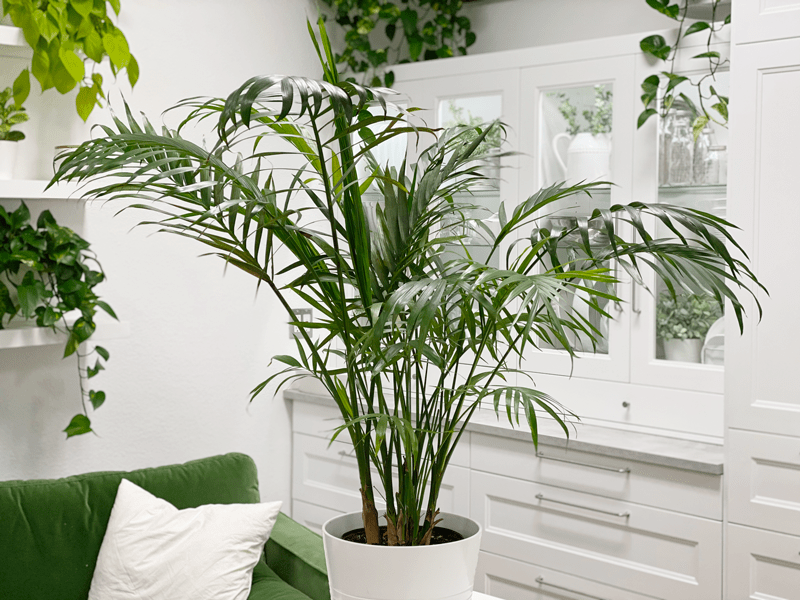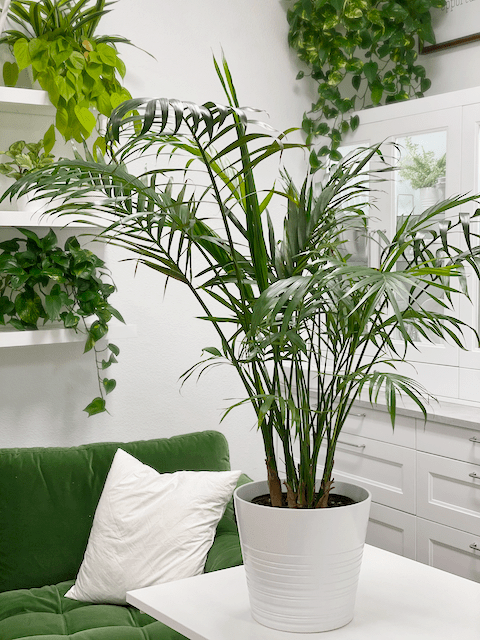

 Add to favorites
Add to favorites
There is a wide range of houseplant palms available, and luckily, most of them have similar growing needs…you just have to be sure you can meet those needs. I don’t say that to scare you. I want you to enjoy your palm, and you won’t be doing that if it is suffering. When plants suffer, we do too, because we want them to be vibrant and full of life. Who wants to hang around with a dead plant?

Palms are great to use to break up a section of a blank wall, to fill an empty corner, to soften the edges of windows or furniture, or to act as a living sculpture at the end of a side table (depending on the size). You can even create a row of houseplant palms to make a lovely living screen or room divider, too! But remember, anytime we are decorating with plants, we must FIRST determine if their new “home” offers the right conditions. Their needs are priority over our decorating desires. Another thing to keep in mind is to avoid too much traffic brushing against or pulling on the fronds—this will weaken the plant and possibly kill the frond.
The amount of water the parlor palm needs will depend on how much light it receives. Brighter light means more water, while lower lighting means less water. For small palms, the surface of the soil should be dry before you water further. For larger palms, the soil should be dry at least one inch down before you water. Be sure to water around the base of the plant to avoid “dry spots.” Dry spots left in the soil could result in a drastic loss of fronds.
The goal is to keep the soil slightly moist without overwatering. As with any indoor plants, grow houseplant palms in containers that have drainage holes, so excess water can escape. Most palms don’t like wet feet and can suffer from root rot if too much water builds up at the bottom of the pot. So when you water your plant, pour water until it comes out the drainage tray, and then empty the tray immediately.
Indoor palms can suffer from too much or too little light. Just like Goldilocks, they need it “just right.” Most indoor palms require natural bright indirect light all year, so if you place the palm near an east-facing or south-facing window with filtered light, it should get enough natural light. They often do well with northern exposure, which is exactly what mine gets. I had to move my plant around a few times to find the right spot for it. Here’s a fun trick…if your palm is getting enough light, it should cast a shadow where it stands.
Indoor palms thrive in warmer temperatures. The ideal temperature is between 60-70 degrees (F). Palms that are kept too cool show signs of cold injury, which includes brownish-red areas on the leaves. To prevent chilling injury, keep plants in a room with a temperature above 45 degrees (F) and away from drafty areas, such as near windows, doors, or air-conditioning units.
Palms require a slow-release or diluted liquid fertilizer, but only when the plant is actively growing. The active growth period for palms is from late winter through early fall. If you are not sure about how much fertilizer to use, it is better to underfeed than overfeed the plant.
 Additional Care
Additional CareDiagnosing what is going wrong with your plant is going to take a little detective work, but even more, it requires patience! First of all, don’t panic and don’t throw a plant out prematurely. Take a few deep breaths and work down the list of possible issues.
Below, I am going to share some typical symptoms that can arise. When I start to spot troubling signs on a plant, I take the plant into a room with good lighting, pull out my magnifiers, and begin by thoroughly inspecting the plant.
If you want to have healthy house plants, you MUST inspect them regularly. Every time I water a plant, I give it a quick look-over. Bugs/insects feeding on your plants reduces the plant sap and redirects nutrients from leaves. Some chew on the leaves, leaving holes in the leaves. Also watch for wilting or yellowing, distorted, or speckled leaves. They can quickly get out of hand and spread to your other plants.
IF you see ONE bug, trust me, there are more. So, take action right away. Some are brave enough to show their “faces” by hanging out on stems in plan site. Others tend to hide out in the darnedest of places, like the crotch of a plant or in a leaf that has yet to unfurl.
A parlor palm in a non- poisonous houseplant, but don’t go chewing on it.
I loved the detailed insights on caring for the Parlor Palm! Your tips on light and watering were especially helpful for someone like me who sometimes struggles with keeping plants happy. I can’t wait to try out your recommendations and see how my plant thrives! Thank you for sharing!
You bet. Enjoy! amie sue
Great post! I’ve always been drawn to the Parlor Palm for its elegance and low-maintenance needs. Your tips on watering and light preferences are super helpful. I’m excited to give it a try and see how it thrives in my home!
I hope it thrives and brings you great joy! blessings, amie sue
Thank you for the detailed care tips for the Parlor Palm! I’ve been considering adding one to my collection, and your insights on light and watering are super helpful. I appreciate how you’ve broken down the requirements. Looking forward to giving it a try!
[…] © Nouveau Raw […]